Reflections from 2025 NY Climate Week
It was great to see so many of you in my hometown last week for New York Climate Week–whether at various events and nightcaps or while giving you a ride through the traffic-clogged streets on my e-bike.
Current Access Level “I” – ID Only: CUID holders, alumni, and approved guests only
Insights from the Center on Global Energy Policy
This Energy Explained post represents the research and views of the author. It does not necessarily represent the views of the Center on Global Energy Policy. The piece may be subject to further revision. Contributions to SIPA for the benefit of CGEP are general use gifts, which gives the Center discretion in how it allocates these funds. Rare cases of sponsored projects are clearly indicated.
For a full list of financial supporters of the Center on Global Energy Policy at Columbia University SIPA, please visit our website at Our Partners. See below a list of members that are currently in CGEP’s Visionary Circle. This list is updated periodically.
The world is projected to increase its new liquefied natural gas (LNG) production capacity by 50 percent[1] by the end of this decade, fueled by the expectation that LNG will be needed as a bridge fuel and the assumption that Russian pipeline gas exports will not return to the European market in the same volumes as before the war in Ukraine, if at all. New LNG production capacity will require gas production from new fields or the expansion of production from existing fields. The US and Qatar are leading this charge, followed by Mozambique and, possibly, Russia, if it can move ahead technically despite global sanctions.[2] [3]
However, a more opaque aspect of LNG supply is the effort to revive more LNG for the future from facilities built in the past. While much focus is placed on the largest top-tier producers or the big four—the US, Qatar, Russia, and Australia—a myriad of other mid-tier producers around the world are not performing as they once were. Six countries (Figure 1) that account for 30 percent of the world’s operating LNG production capacity—Malaysia, Indonesia, Nigeria, Trinidad, Algeria, and Egypt—were utilizing 63 percent of that capacity in 2023 (in fact, they produced at only 55 percent of capacity in the third quarter of the year). In contrast, the big four, which account for 65 percent of the world’s operating LNG production capacity, have been running at 95 percent capacity utilization over the past five years.[4]
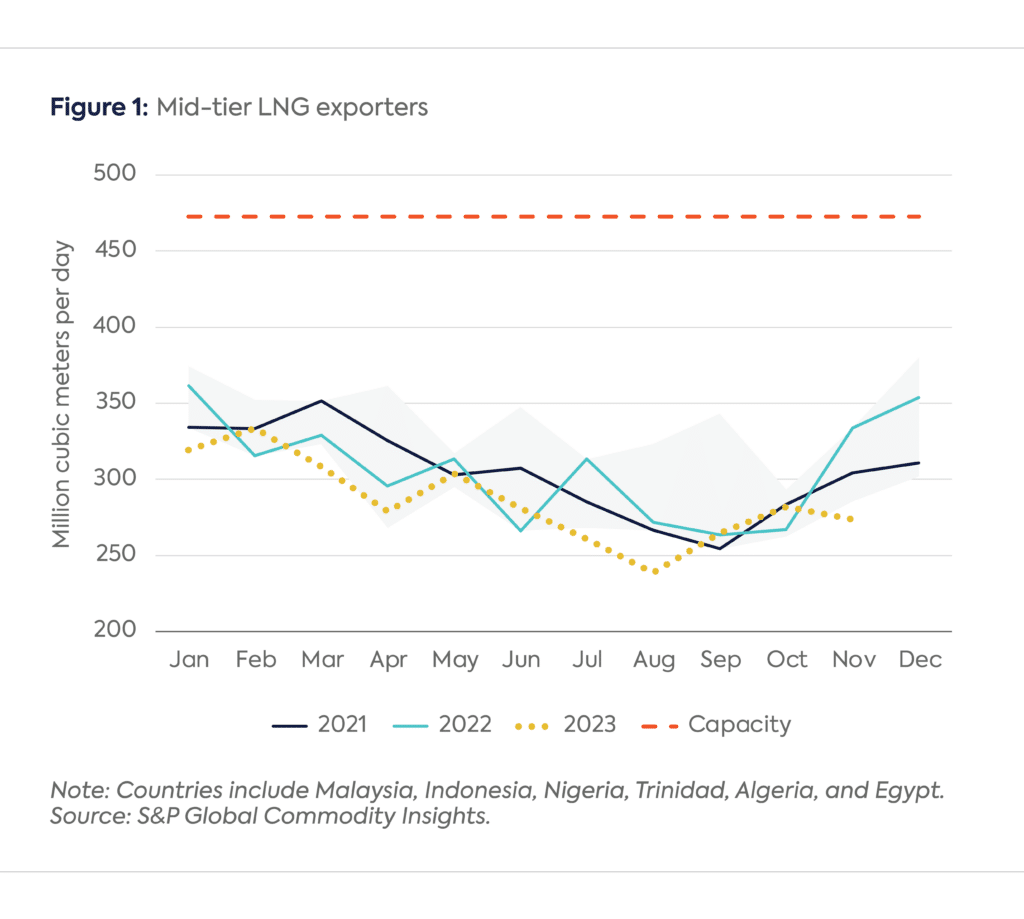
Now, however, many of the host countries for these LNG facilities are in the process of tweaking policy to turn around LNG producing assets to put them in a strong position to compete in this market, as the author discusses in this article.
Reasons for these facilities falling behind include diminishing reserves, lack of financial and tax incentives for additional drilling, aging equipment, gas pipeline issues in feeding the LNG plants, and the prioritization of domestic gas demand over LNG exports. In 2010, these six countries (Figure 2) produced LNG at 95 percent of capacity, with several months pushing above 100 percent of nameplate capacity. (Plants can go above 100 percent, but rarely on a sustainable basis.) This utilization of capacity has deteriorated since then, with Malaysia the only country not suffering major declines due to capacity additions at existing and new locations.
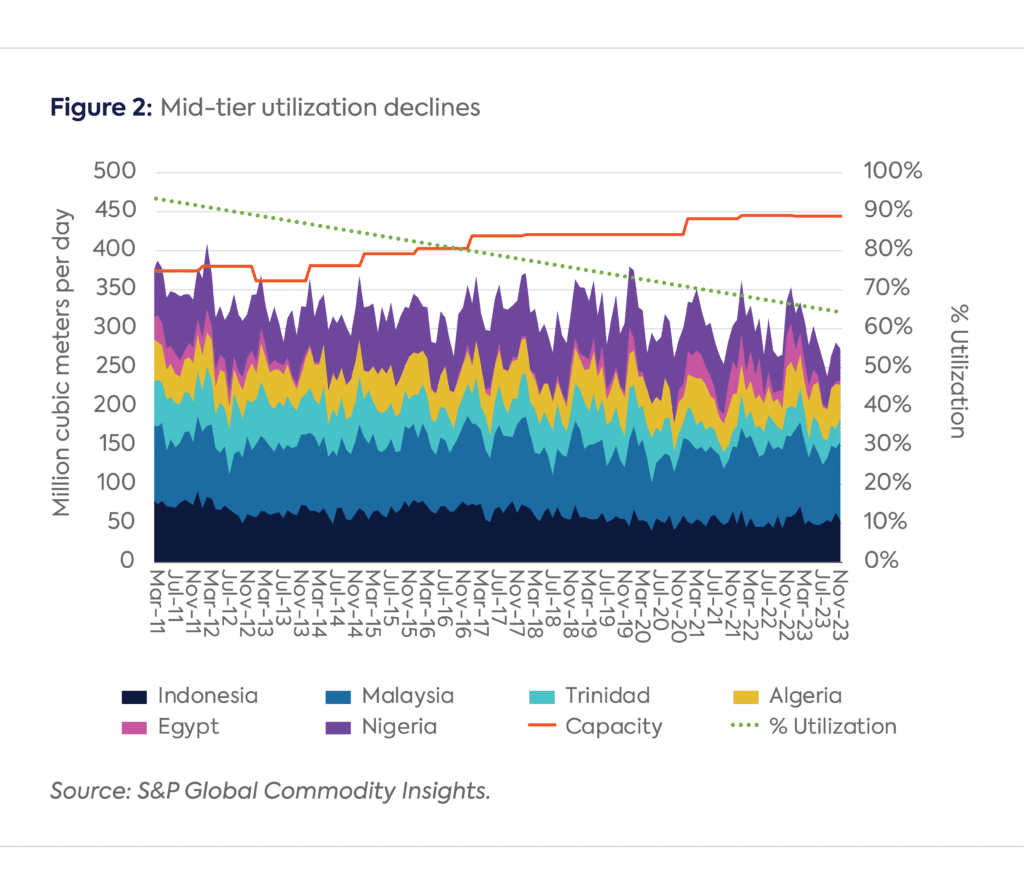
The loss in volumes has been steady for more than a decade, and is by now significant, which means that, if reversed this decade, these assets would add to the already crowded field of incremental LNG supply coming from new facilities. Collectively, these facilities are producing 150–200 million cubic meters per day (Mcm/d) below their designed capacity, which is equivalent to 10–13 percent of LNG supply in the market in 2023, or roughly 75 percent of current Qatari LNG production capacity.[5]
Seeing the opportunity and the threat coming from new LNG production capacity, a plethora of policy initiatives are underway in these mid-tier LNG-producing countries to revive this legacy production.
Several of the host governments are trying to facilitate gas imports from nearby countries that do not have the ability to export LNG themselves. Two examples stand out: Trinidad could start importing gas from Venezuela now that US sanctions have eased, and Egypt could import significantly more gas from Israel. In each case, nearby gas reserves either remain idle or are constrained by a lack of sufficient export outlets or a large enough domestic market for the gas.
For Trinidad to utilize Venezuelan gas reserves, a pipeline connection of less than 50 kilometers would be required to join the long-idle gas reserves in eastern Venezuela to Trinidad’s offshore pipeline infrastructure, which feeds its four LNG trains at Point Fortin.[6] The major remaining impediment is the review of sanctions by the US every six months, which puts any type of Venezuelan upstream investment at perpetual risk without some sort of exemption built in. A greenlight now would mean first gas flows by 2026.[7]
The recent attack by Hamas on Israel has certainly clouded the picture for increased Israeli gas flowing into Egypt. Mediterranean gas trade was trending toward more Israeli gas use in Egypt, to meet both domestic shortfalls and to raise LNG exports. If this trade is permanently lost, which seems unlikely, Egyptian upstream investments are likely to receive a boost. Gaza’s development of the offshore Marine field,[8] which could have reduced or eliminated imports from Israel, now seems to be delayed indefinitely. Egypt is now so short of gas[9] that it has begun to import LNG just to balance domestic markets.
Algeria possesses internal and external options for reviving its LNG exports. Like Trinidad and Egypt, the country had been struggling to keep up with domestic demand and maintain a higher level of exports, but it seems to be righting the ship. Four new fields are under development in the southwest part of the country[10] that could push up LNG production, although sizable amounts of spare capacity, to export by pipeline, are also an option. Projects including Isarene, Hassi Bahamou, Hassi Tidjerane, and Tinerkouk are moving ahead after a flurry of new deals signed in the wake of Russia’s invasion of Ukraine. Algeria intends to launch its first oil and gas licensing round in nine years,[11] the first under a revised 2019 hydrocarbons law whose implementation decrees are finally in place. The round will include 10 to 12 blocks. A project to bring West African gas through the Algerian grid is also on the books, but is much more of a longshot.[12]
In Malaysia, new Revenue/Cost index (R/C) production sharing contracts now govern all exploration licenses. In 2020, Malaysia introduced revenue-sharing contracts, Small Field Asset (SFA) and Late Life Asset (LLA) production sharing contracts (PSCs). Both include royalty at 10 percent and biddable contractor revenue split.[13] Enhanced Profitability Terms (EPT) were also introduced as part of the 2021 licensing round for shallow-water exploration blocks. Future gas supply for Malaysia’s primary Bintulu complex is largely located onshore and now hinges on the development of Malaysia’s vast, but costly and technically challenging, sour gas fields.
Even Indonesia, suffering from a long slump[14] in new development after being one of the industry’s original success stories in the 1980s and ’90s, is showing a pulse. Two major Indonesian gas projects have been revived with new hope. Most of its new upstream is targeted at meeting domestic and regional demand, as parts of Indonesia have become net import markets. The one major new LNG project, Abadi LNG, is unlikely to start before the end of the decade.[15] The 10 million tons per annum (MTPA) project will be fed by the Masela gas block, which has proven reserves of 19 trillion cubic feet (Tcf) and 225 million barrels of condensate. Indonesia’s older facilities at Arun have shut due to lack of nearby reserve potential, while the Bontang facility operates at reduced rates. Italy’s Eni is planning to send its 5 Tcf in newly discovered and acquired gas supplies in the Geng North area to Bontang.[16]
Reviving gas production in countries with underutilized LNG capacity should be a policy priority for host governments. Even in a more crowded market later this decade, the commercial advantages are plain to see, particularly among legacy LNG producers in Asia, where most of the demand growth will occur. For experienced gas producers, focusing on acreage in and around legacy LNG capacity would also be a way to enter the LNG business quickly, without the higher capital costs of building new LNG capacity.
CGEP’s Visionary Circle
Corporate Partnerships
Occidental Petroleum Corporation
Tellurian Inc
Foundations and Individual Donors
Anonymous
Anonymous
the bedari collective
Jay Bernstein
Breakthrough Energy LLC
Children’s Investment Fund Foundation (CIFF)
Arjun Murti
Ray Rothrock
Kimberly and Scott Sheffield
[1] https://giignl.org/giignl-releases-2023-annual-report/
[2] https://www.reuters.com/business/energy/japan-says-sanctions-russia-will-affect-lng-project-2023-11-07/
[3] While Australia is one of the largest producing countries in the world, it has no additional LNG projects under construction or proposed at this time other than the 5 MTPA Pluto LNG train scheduled for mid-2026.
[4] S&P Global LNG Navigator. https://xplore.spglobal.com/default.aspx?ID=0&SRC=BOTTOMRIGHT-0
[5] Based on a calculation using maximum monthly supply relative to nameplate capacity. Capacity is based on annualized figures and does not build in maintenance. S&P Global LNG Navigator. https://xplore.spglobal.com/default.aspx?ID=0&SRC=BOTTOMRIGHT-0
[6] https://www.argusmedia.com/en/news/2500216-trinidad-expects-venezuelas-dragon-gas-in-2-years
[7] https://www.reuters.com/business/energy/venezuela-close-approving-offshore-gas-license-with-trinidad-shell-2023-11-20/
[8] https://www.jpost.com/business-and-innovation/energy-and-infrastructure/article-774864
[9] https://www.spglobal.com/commodityinsights/en/market-insights/latest-news/lng/110623-egypt-imports-rare-lng-cargo-amid-scarcity-of-israeli-gas#:~:text=Egypt%20rarely%20imports%20LNG%2C%20with,loaded%20with%20LNG%20and%20oil
[10] https://www.eurasiareview.com/21032023-algeria-energy-profile-major-oil-and-natural-gas-producer-analysis/
[11] https://www.africa-energy.com/news-centre/article/algeria-gets-busy-flurry-late-2022-upstream-deals-least-theory
[12] https://intellinews.com/niger-coup-threatens-nigeria-morocco-30bcm-gas-pipeline-project-286426/
[13] https://www.woodmac.com/reports/upstream-oil-and-gas-malaysia-upstream-fiscal-summary-16096192/
[14] https://www.reuters.com/business/energy/indonesias-long-delayed-major-gas-projects-2023-08-11/
[15] https://www.reuters.com/business/energy/indonesias-long-delayed-major-gas-projects-2023-08-11/
[16] https://lngprime.com/asia/eni-plans-to-send-new-indonesian-gas-supplies-to-bontang-lng-plant/93539/
President Putin's trip to China marks a turning point in the trajectory of Russian pipeline gas flows to the country.
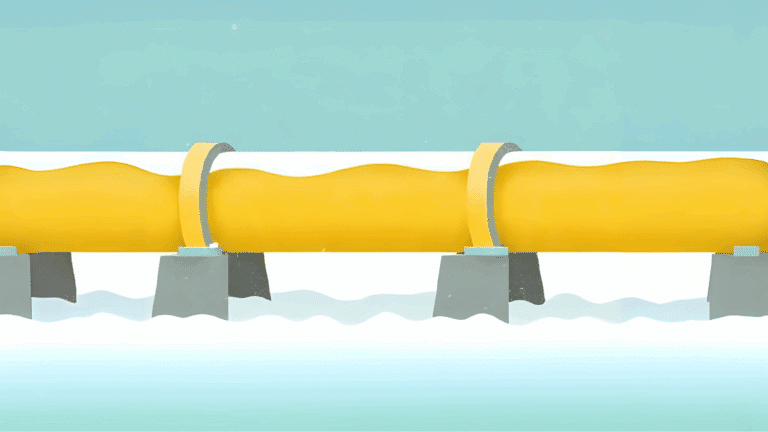
Despite producing little natural gas, the EU could become the most powerful entity in global gas markets in the decades to come.
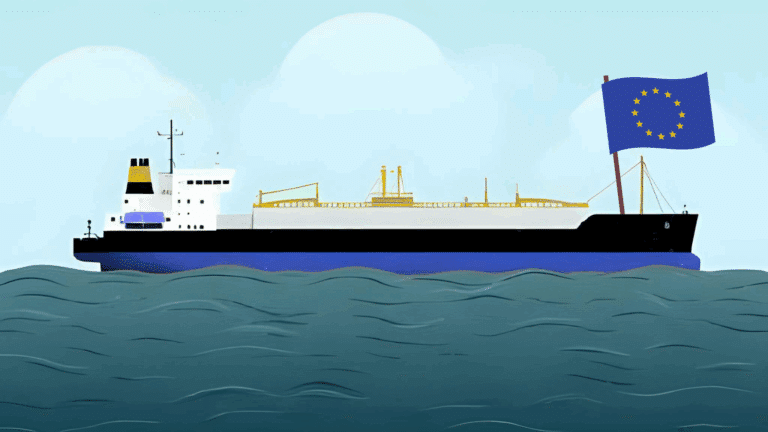
The European Commission published a proposed regulation on June 17 to end Russian gas imports by the end of 2027.
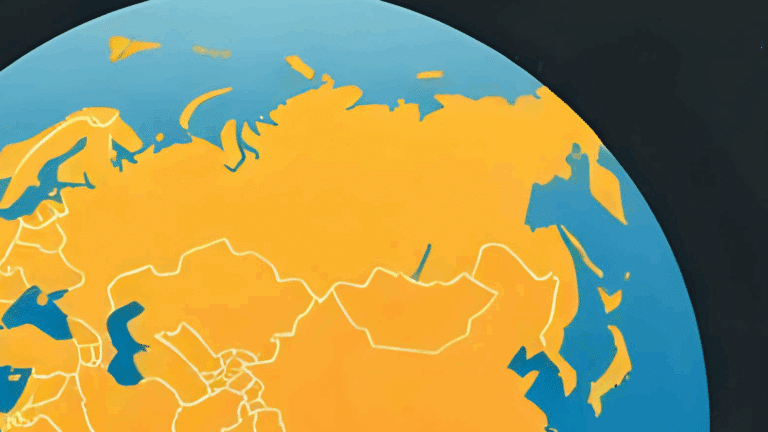
China’s dependence on the energy supplies that move through the Strait of Hormuz makes it especially vulnerable to any possible closure of the waterway by Iran in retaliation for attacks by Israel and the United States.
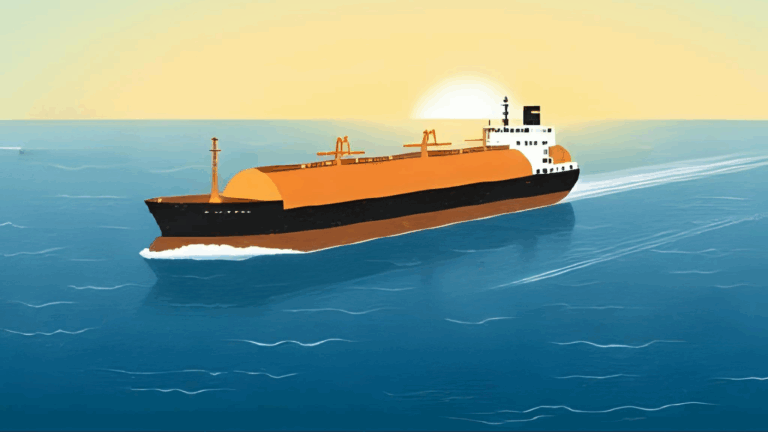
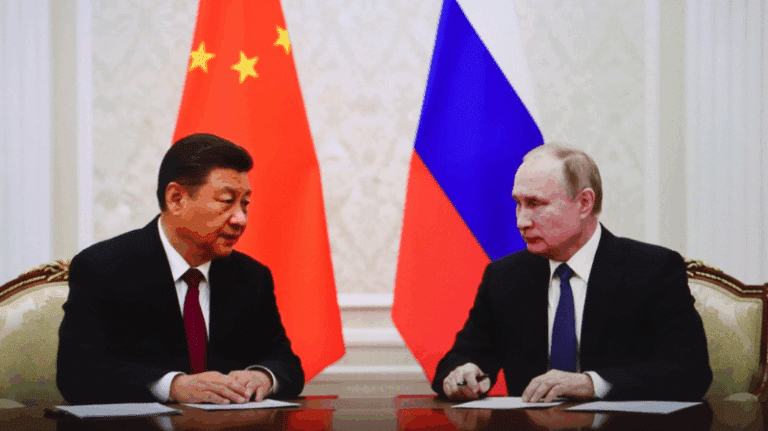
Qatar is entering the world's next LNG expansion phase with a large share of uncontracted supply, and how it will navigate this phase is the central uncertainty in the LNG market.

L'essentiel de l'actualité du gaz naturel, des gaz renouvelables et de l'hydrogène
